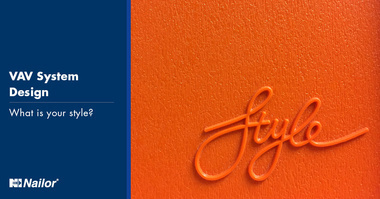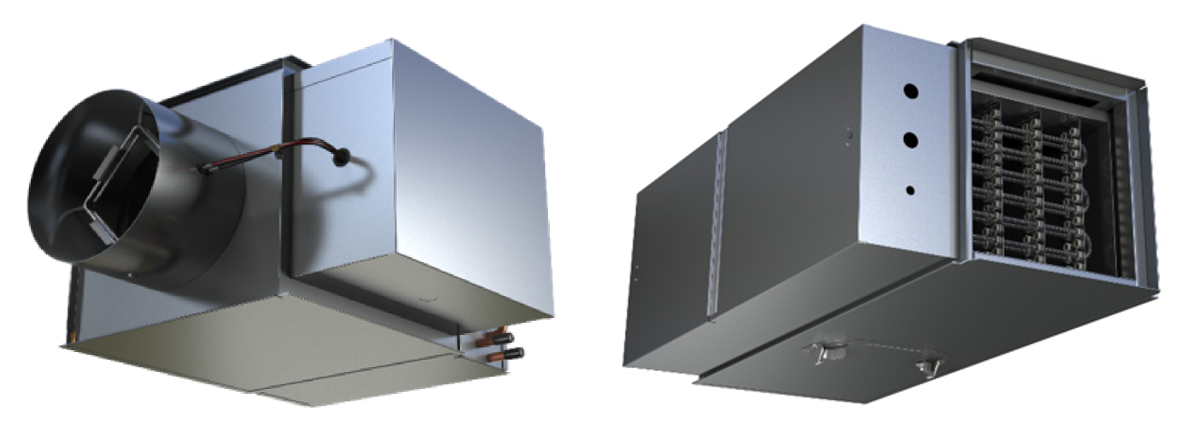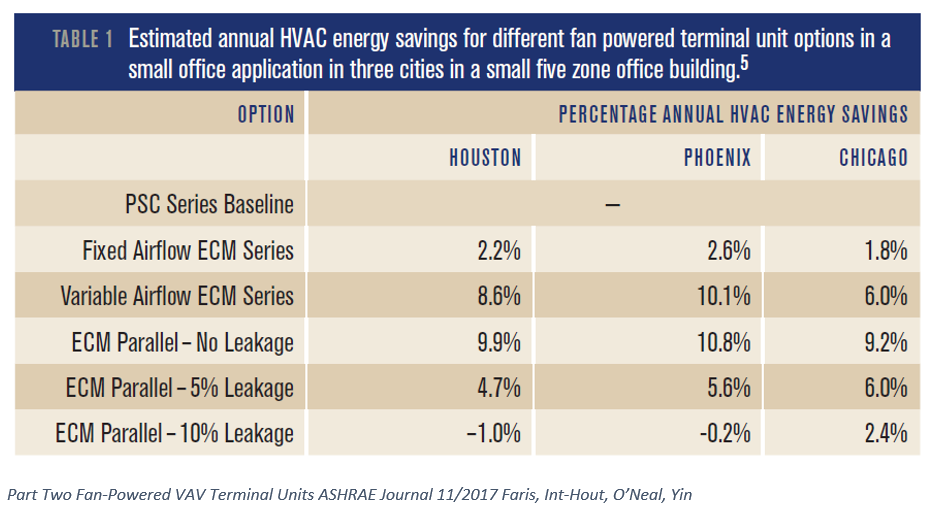
The Houston, Seattle, and Washington DC markets largely specify systems that utilize series fan-powered terminal units in all zones. Dallas and Portland, OR, specify parallel fan-powered units on the exterior with single duct units in the interior. The equipment and configuration of selected terminal units appear to be a matter of style. There are many reasons why different areas could have different design standards. Regardless, analyzing why you would select one style over the other could provide some value.
Equipment Reminder
Terminal units are used within a Variable Air Volume (VAV) System to control the airflow and temperature delivered to a zone. Single duct, parallel fan-powered, and series fan-powered units are connected to an air handling unit (AHU) that supplies the terminal units with cooled and dehumidified air.
Single Duct Terminal Units
The single duct terminal unit consists of a flow sensor, actuator, damper, and in some cases a heating coil. When the controlling thermostat calls for additional cooling, the actuator will start to open the damper to provide more cool air to the room. During this operation, the terminal unit relies on airflow delivered by the AHU. During heating, the single duct unit operates in the same way, but a heating coil reheats the air to maintain the space set point.

Parallel Fan Powered Terminal Units
Parallel FPTUs act as a single duct box during cooling. During heating, the primary damper closes to the minimum ventilation rate, and the fan/heating coil starts. The fan pulls air from the plenum to make up the required airflow to satisfy the heat in the space. The Parallel unit needs pressure from the air handling unit, like the single duct, to serve the space during cooling.

Series Fan Powered Terminal Units
Series FPTUs have a fan located in the primary airflow. When the AHU is operating the Series unit fan must be operational so that the primary airflow makes it to the room. Because the airflow is delivered to the room through the unit fan, the AHU is only required to deliver air to the terminal unit.

Building Loads
The traditional rule of thumb for an office building mechanical design is exterior zones require the ability to heat and cool their zones, while the interior zones only require cooling. The thought is that the exterior zones would handle the environmental building loads and the interior zones will only have to address internal loads such as computers and people.
With the increase in energy efficiency in lighting and equipment, the heating loads from equipment in the space have dropped dramatically. In many cases, this allows the minimum ventilation rates for interior zones to over-cool the room. Interior zones are sometimes equipped with heating coils to maintain occupant comfort.
System Style
The two system styles that have emerged are Parallel + Single Duct and Series Units.
Parallel + Single Duct
With these systems, the parallel units cover the exterior zones while single duct units serve the interior. These two unit types work together well because they require similar pressures from the AHU to operate.
Series Units
When designing a system with series units, use them on both interior and exterior zones. Because they require little to no pressure at the inlet to operate, using series units throughout the system allows the designer to reduce the required pressure from the air handling unit, sometimes up to 1" w.g. The result is either a smaller fan and motor (saving $) or the fan and motor to operate at a slower speed (saving $).
The use of series units on the interior provides another benefit. When the room is just slightly over-cooled, the fan can increase and induce more plenum air into the airflow. Just the increase in plenum air can warm the airflow enough to satisfy the demand of the space, reducing the use of the heating coil.
If the designer pairs series units with single duct units, most of this benefit is lost because the AHU pressure would have to increase to accommodate the requirements of the single duct units.
Pros & Cons of Each Style
Parallel + Single Duct
- Pros
- The parallel fan doesn't run continuously, reducing unit energy use
- Single duct units do not require a fan, reducing noise on the interior
- Single duct units are less expensive
- Cons
- Higher pressures required from the AHU fan
- Larger fan/motor
- Higher fan/motor energy use
- Higher duct leakage
- Parallel units rely on a backdraft damper during cooling to eliminate unit leakage
- Units can leak up to 10% of the primary airflow in cooling
- Single duct units must engage the heating coil if higher temperatures are demanded
- Higher pressures required from the AHU fan
Series Units
- Pros
- Lower pressure from the air handling unit
- Smaller motor/fan
- Lower motor/fan energy use
- Lower duct leakage
- No leakage from the unit
- Interior zones can offset heating load from plenum air induction
- Lower pressure from the air handling unit
- Cons
- Unit energy use is continuous during cooling/heating
- Series units on the interior will have a higher up-front cost over single duct
Science
A study performed in conjunction Texas A&M, located here, looked at how the decision on what type of fan-powered terminal units used could affect the overall building energy load. The study compared EC Motor Series FPTUs with constant volume and variable volume controls, as well as Parallel Units with EC Motors to a baseline of PSC series units. The results were impressive, utilizing variable volume series units with EC Motors saved the building (depending on location) 6-10% of total HVAC energy costs. Using Parallel units would save 9-10% in an ideal world where the unit didn’t leak, which is never the case. The study found that most units leaked 5-10%, which reduced their energy savings to -1-6%.

Style Impacts Building Performance
The selection of terminal units can have a large impact on how efficient the overall HVAC system performs. If you have any questions regarding the different styles or about HVAC systems in general, please contact us.